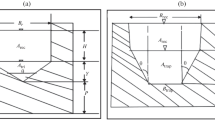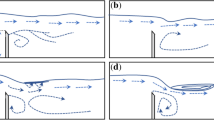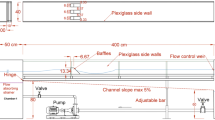Abstract
A rectangular slit weir is used to measure small discharges (Q < 5 L/s) and contraction ratios (b/B \(\le\) 0.25). Various discharge relationships were reported in the literature for calculating the discharge capacity of slit weirs in terms of frontal flow. However, this is not valid for lateral flow. In the current study, the side slit weir flow was investigated experimentally using piezometric heads over the weirs. The discharge coefficient was investigated for side slit weirs with different contraction ratios, which ranged from 0.075 to 0.25. Accordingly, the discharge coefficients were calculated using the Schmidt approach. Moreover, the outflow discharge of sharp-crested side slit weir was analyzed using the incomplete self-similarity theory (ISS) and dimensional analysis. The new discharge model was theoretically created based on the experimental results obtained from laboratory tests. The results of the current study indicated that the contraction ratio, dimensionless head over the weir, and Froude number were dominant parameters over the discharge of sharp-crested side slit weirs. Within this framework, slit weirs can be used laterally as water intake structures for small discharges. Furthermore, a nonlinear equation including all effective parameters is proposed to obtain the discharge capacity of sharp-crested side slit weirs with the highest accuracy.


















Similar content being viewed by others
Data Availability
The data is available upon reasonable request.
Abbreviations
- B :
-
Width of main channel (m)
- b :
-
Length of side slit weir (m)
- C d :
-
Discharge coefficient (-)
- F1 :
-
Froude number at upstream of side weir (-)
- F2 :
-
Froude number at downstream of side weir (-)
- g :
-
Acceleration due to gravity (m/s2)
- h 1 :
-
Piezometric head over the weir at the upstream section (m)
- h 2 :
-
Piezometric head over the weir at the downstream section (m)
- h 3 :
-
Piezometric head over the weir at the center section (m)
- k w :
-
Critical water depth (m)
- p :
-
Crest height (m)
- Q 1 :
-
Total discharge in main channel at upstream end of side weir (m3/s)
- Q 2 :
-
Total discharge in main channel at downstream end of side weir (m3/s)
- Q :
-
Flow rate over side weir (m3/s)
- Q m :
-
Measured flow rate over side weir (m3/s)
- Q c :
-
Calculated flow rate over side weir (m3/s)
- q :
-
Unit discharge (m3/s m)
- Re:
-
Reynolds number (-)
- S 0 :
-
Slope of main channel (-)
- S E :
-
Slope of energy (-)
- V 1 :
-
Mean velocity at upstream of side weir (m/s)
- V 2 :
-
Mean velocity at downstream of side weir (m/s)
- We:
-
Weber number (-)
- x :
-
Distance along the side slit weir (m)
- y 1 :
-
Flow depth at upstream (m)
- y 2 :
-
Flow depth at downstream (m)
- α 1 :
-
Kinetic energy coefficient (-)
- α 2 :
-
Kinetic energy coefficient (-)
- Δh :
-
The difference between upstream and downstream flow depths (mm)
- Δ\({h}_{s}\) :
-
Friction loss (-)
- η :
-
Outflow efficiency (-)
- μ :
-
Dynamic viscosity (kg/m s)
- ρ :
-
Mass density of water (kg/m3)
- σ :
-
Surface tension (kg/s2)
- ξ :
-
Correction coefficient for Schmidt approach (-)
References
Akbari M, Salmasi F, Arvanaghi H et al (2019) Application of gaussian process regression model to predict discharge coefficient of gated piano key weir. Water Resour Manage 33:3929–3947. https://doi.org/10.1007/s11269-019-02343-3
Aydin I, Altan-Sakarya AB, Ger AM (2006) Performance of slit weir. J Hydraul Eng 132:987–989. https://doi.org/10.1061/(asce)0733-9429(2006)132:9(987)
Aydin I, Ger AM, Hincal O (2002) Measurement of small discharges in open channels by slit weir. J Hydraul Eng 128:234–237. https://doi.org/10.1061/(asce)0733-9429(2002)128:2(234)
Bagheri S, Heidarpour M (2012) Characteristics of flow over rectangular sharp-crested side weirs. J Irrig Drain Eng 138:541–547. https://doi.org/10.1061/(asce)ir.1943-4774.0000433
Bagheri S, Kabiri-Samani AR, Heidarpour M (2014) Discharge coefficient of rectangular sharp-crested side weirs Part II: Domínguez’s method. Flow Meas Instrum 35:116–121. https://doi.org/10.1016/j.flowmeasinst.2013.10.006
Barenblatt GI (1979) Similarity Self-Similarity and Intermediate Asymptotics. Consultants Bureau, New York
Barenblatt GI (1987) Dimensional Analysis. Gordon & Breach, Amsterdam
Behroozi AM, Vaghefi M (2022) Experimental and numerical study of the effect of zigzag crests with various geometries on the performance of a-type piano key weirs. Water Resour Manage 36:4517–4533. https://doi.org/10.1007/s11269-022-03261-7
Bijankhan M, Di Stefano C, Ferro V (2018) Generalised stage–discharge relationship for rectangular weirs. Proc Inst Civ Eng Water Manage 171:125–133. https://doi.org/10.1680/jwama.16.00102
Bijankhan M, Ferro V (2017) Dimensional analysis and stage-discharge relationship for weirs: A review. J Agric Eng 48:1–11. https://doi.org/10.4081/jae.2017.575
Borghei SM, Jalili MR, Ghodsian M (1999) Discharge coefficient for sharp-crested side weir in subcritical flow. J Hydraul Eng 125:1051–1056
Bos MG (1989) Discharge Measurement Structures. International Institute for Land Reclamation and Improvement, Wageningen
De Marchi G (1934) Essay on the performance of lateral weirs. L’ Energia Electtrica 11:849–860
Domínguez F (1935) Hidráulica. Editorial Universitaria Santiago
Durga Rao KHV, Pillai CRS (2008) Study of flow over side weirs under supercritical conditions. Water Resour Manage 22:131–143. https://doi.org/10.1007/s11269-007-9153-4
Emiroglu ME, Agaccioglu H, Kaya N (2011) Discharging capacity of rectangular side weirs in straight open channels. Flow Meas Instrum 22:319–330. https://doi.org/10.1016/j.flowmeasinst.2011.04.003
Emiroglu ME, Ikinciogullari E (2016) Determination of discharge capacity of rectangular side weirs using Schmidt approach. Flow Meas Instrum 50:158–168. https://doi.org/10.1016/j.flowmeasinst.2016.06.021
Ferro V, Aydin I (2018) new theoretical solution of stage-discharge relationship for slit weirs. J Irrig Drain Eng 144:06018001. https://doi.org/10.1061/(asce)ir.1943-4774.0001285
Kartal V, Emiroglu ME (2022) Experimental analysis of combined side weir-gate located on a straight channel. Flow Meas Instrum 88:102250. https://doi.org/10.1016/j.flowmeasinst.2022.102250
Maranzoni A, Pilotti M, Tomirotti M (2017) Experimental and numerical analysis of side weir flows in a converging channel. J Hydraul Eng 143:04017009. https://doi.org/10.1061/(asce)hy.1943-7900.0001296
Novák P, Čabelka J (1981) Models in hydraulic engineering. Pitman, Boston
Ozbek T (2009) Hydraulics of open channel flows and hydraulic structures. Teknik Publication, Ankara
Parsamehr P, Kuriqi A, Farsadizadeh D et al (2022) Hydraulic jump over an adverse slope controlled by different roughness elements. Water Resour Manage 36:5729–5749. https://doi.org/10.1007/s11269-022-03330-x
Roushangar K, MajediAsl M, Shahnazi S (2021) Hydraulic performance of PK weirs based on experimental study and kernel-based modeling. Water Resour Manage 35:3571–3592. https://doi.org/10.1007/s11269-021-02905-4
Schmidt M (1954) Zur frage des abflusses uber streichwehre. Techaniv Berlin-Charlottenbury Mitteilung 41:1–68
Vatankhah AR (2013) Water surface profiles along a rectangular side weir in a u-shaped channel (analytical findings). J Hydrol Eng 18:595–602. https://doi.org/10.1061/(ASCE)HE.1943-5584.0000657
Vatankhah AR (2019) Stage-discharge relationship for sharp-crested rectangular slit weirs. J Irrig Drain Eng 145:06019006. https://doi.org/10.1061/(asce)ir.1943-4774.0001419
Yousefi SR, Amiri O, Salavati-Niasari M (2019) Control sonochemical parameter to prepare pure Zn0.35Fe2.65O4 nanostructures and study their photocatalytic activity. Ultrason Sonochem 58:104619. https://doi.org/10.1016/j.ultsonch.2019.104619
Yousefi SR, Alshamsi HA, Amiri O, Salavati-Niasari M (2021a) Synthesis, characterization and application of Co/Co3O4 nanocomposites as an effective photocatalyst for discoloration of organic dye contaminants in wastewater and antibacterial properties. J Mol Liq 337:116405. https://doi.org/10.1016/j.molliq.2021a.116405
Yousefi SR, Sobhani A, Alshamsi HA, Salavati-Niasari M (2021b) Green sonochemical synthesis of BaDy2NiO5/Dy2O3and BaDy2NiO5/NiO nanocomposites in the presence of core almond as a capping agent and their application as photocatalysts for the removal of organic dyes in water. RSC Adv 11:11500–11512. https://doi.org/10.1039/d0ra10288a
Acknowledgements
The authors are greatly thankful to Firat University, Turkey.
Author information
Authors and Affiliations
Contributions
All authors contributed to experiments, conceptualization, methodology, validation, multiple regression analysis, investigation, resources, writing-original draft preparation, and visualization. All authors have read and agreed to the published version of the manuscript.
Corresponding author
Ethics declarations
Ethical Approval
This article does not contain any studies with human participants or animals performed by any of the authors.
Consent to Participate
Informed consent was obtained from all individual participants included in the study.
Consent for Publication
Informed consent was obtained from all individual participants included in the study.
Competing Interests
The authors declare that they have no conflict of interest.
Additional information
Publisher's Note
Springer Nature remains neutral with regard to jurisdictional claims in published maps and institutional affiliations.
Appendix
Appendix
1.1 Schmidt Approach
To determine the discharge capacity of side weir for subcritical, Schmidt (1954) proposed an approach. The energy equation was given as follows:
where \(\Delta {h}_{s}\)=friction loss. \(\Delta {h}_{s}\) could be obtained from the Manning–Strickler formula as \(\Delta {h}_{s}={S}_{E} b\). Schmidt (1954) assumed that the channel slope and energy grade line are nearly equal (\({S}_{E}b\cong {S}_{0}b\)). The slope of channel is very small (sinθ ≅ tanθ = So). Therefore, it is assumed that the specific energy is constant along the side weir.
Energy correction coefficients can be taken into account as \({\alpha }_{1}={\alpha }_{2}=1.1\) using the trial and error method. To verify the energy correction coefficients, \(\xi\) was obtained experimentally. For \(\Delta {h}_{s}={S}_{E}b\cong {S}_{0}b\), Eq. (28) is formulated as follows:
in which \(\xi\)=correction coefficient for the Schmidt approach. Schmidt (1954) stated that Poleni’s equation was applied to this approach.
or
in which \({h}_{a}\)=average piezometric head according to two points and three points, respectively. \({h}_{1},{h}_{2},{h}_{3}\) are piezometric heads over the weir at the upstream (C1), downstream (C2), and center (C3) sections of the side weir, respectively.
Friction loss was considered in the formula or theweir length in the Schmidt approach, where was much larger, Eq. (33) could be utilized instead of Eq. (29) (Ozbek 2009).
Rights and permissions
Springer Nature or its licensor (e.g. a society or other partner) holds exclusive rights to this article under a publishing agreement with the author(s) or other rightsholder(s); author self-archiving of the accepted manuscript version of this article is solely governed by the terms of such publishing agreement and applicable law.
About this article
Cite this article
Kartal, V., Emiroglu, M.E. Hydraulic Performance of Sharp-Crested Side Slit Weirs. Water Resour Manage 37, 1297–1319 (2023). https://doi.org/10.1007/s11269-023-03433-z
Received:
Accepted:
Published:
Issue Date:
DOI: https://doi.org/10.1007/s11269-023-03433-z




